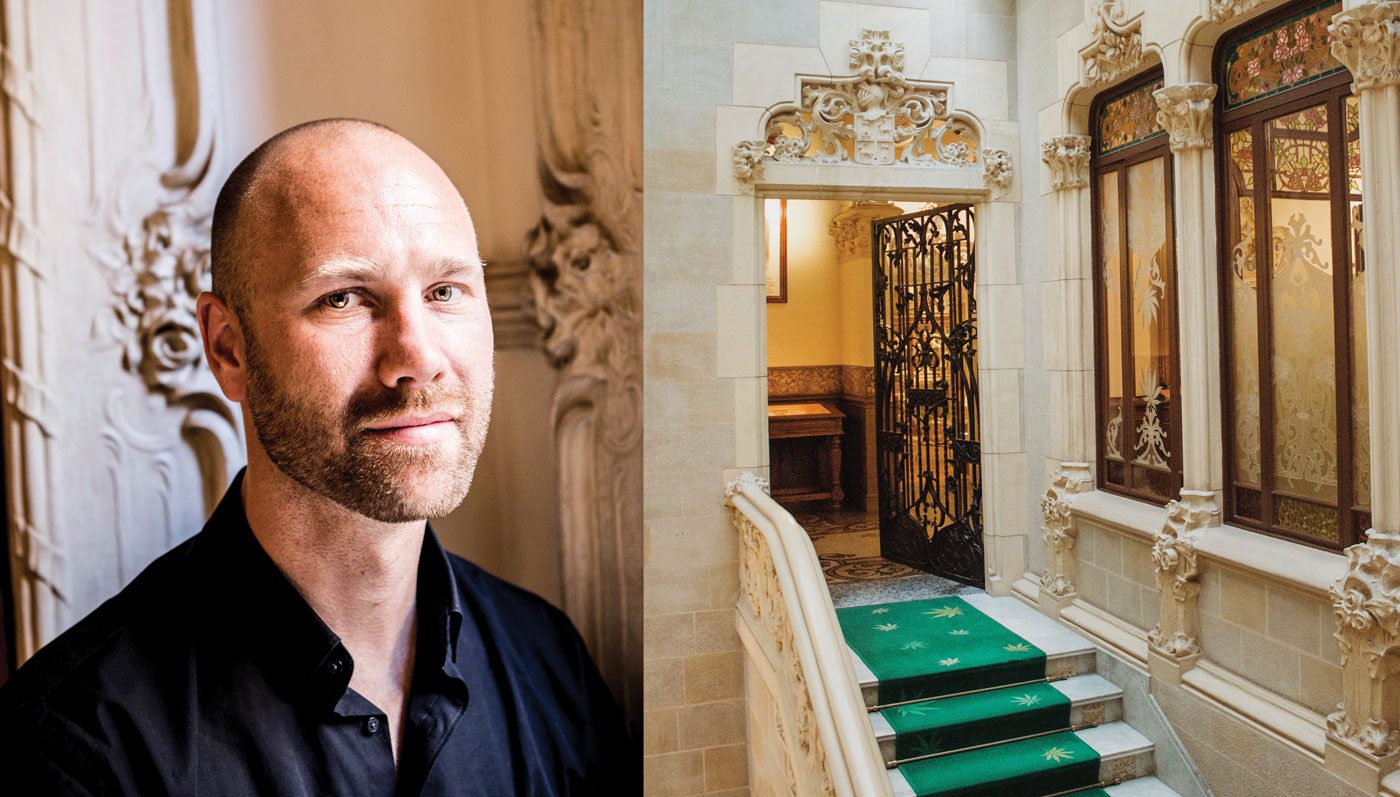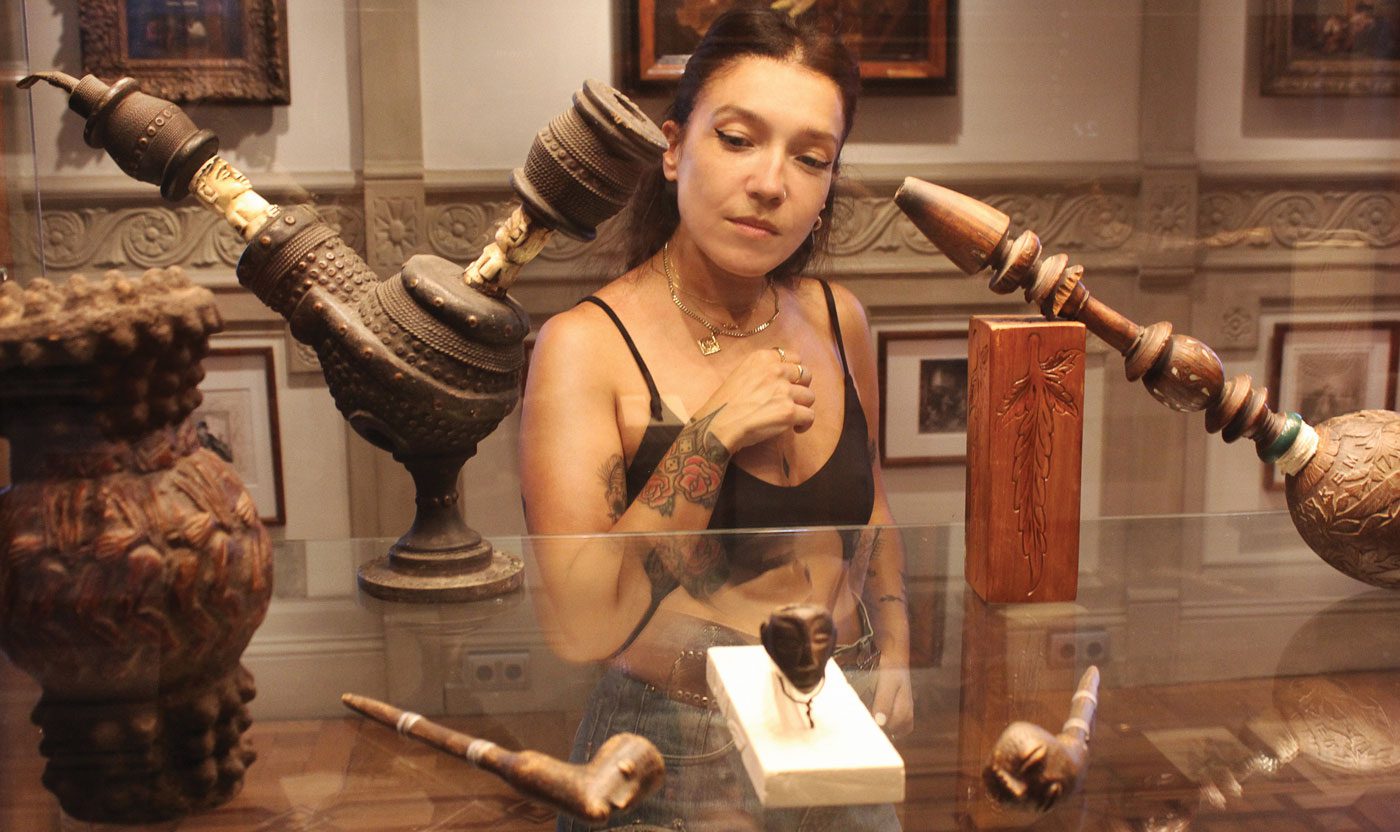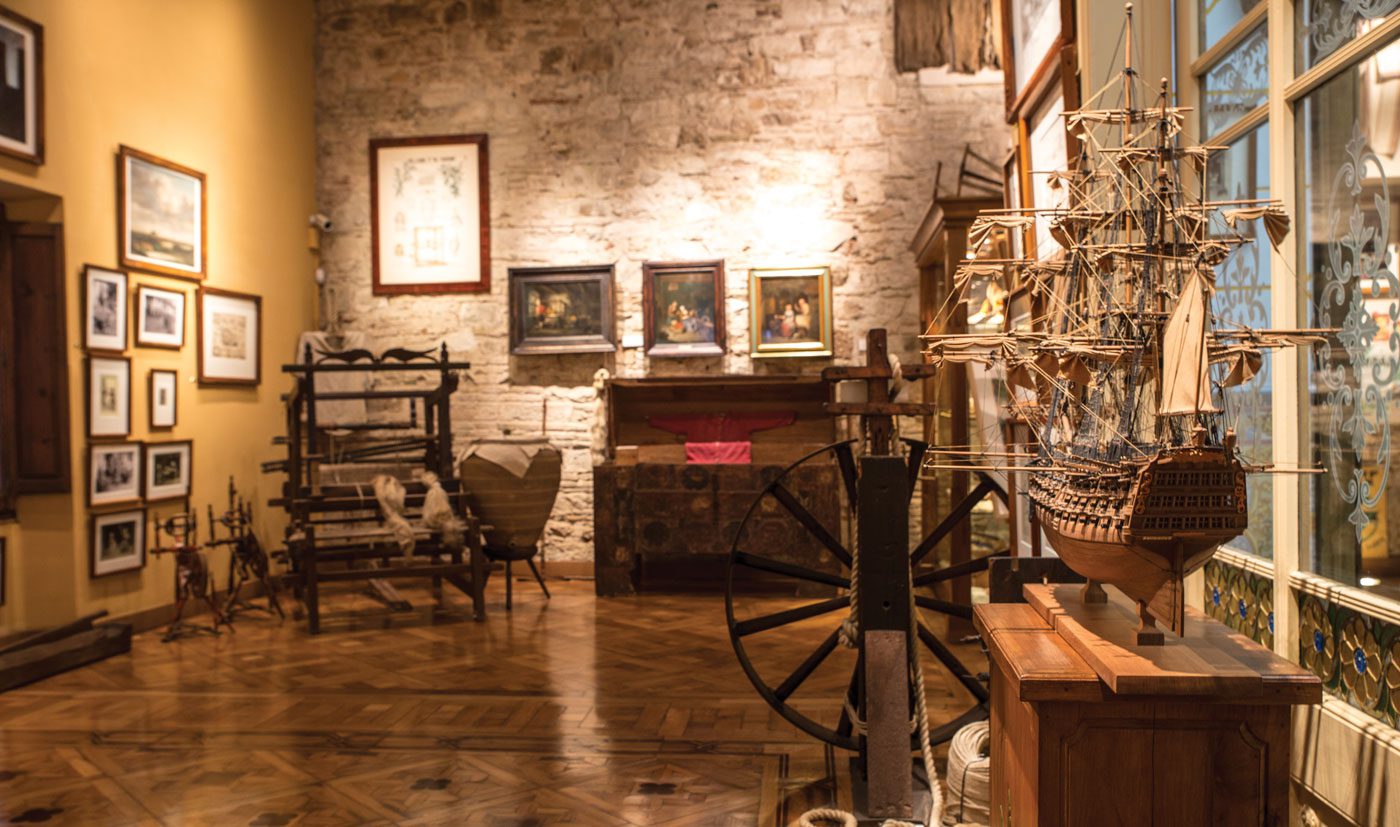In 2019 I got the amazing opportunity to travel to Barcelona to see the city and attend Spannabis. While there, a key spot to visit was the Hash Marihuana & Hemp Museum. It’s located in on Carrer Ample, on the edge of Barcelona’s Gothic Quarter in the Old City, which is definitely a place to walk around. There is also a museum exhibit in Amsterdam, which I hope to visit someday. In Barcelona, the museum is housed in a building called the Palau Mornau, a grand Modernisme building of the type of architecture Barcelona is known for. It’s a work of art in itself. It’s a pleasure to walk around inside it, not even taking into consideration the many cool things contained within it. The Palace Mornau dates back to the 1500s, when it was built as a palace for the noble Santcliment family. They lived there for two centuries until the building transferred ownership to Josep Francesc Mornau, and later Joan Nadal de Vilardaga, the brother of the mayor of Barcelona. It was revamped into the modernist style it is on now, complete with stained glass windows, floral wrought iron balconies, a faux stone facade, and a unique design for the ceilings, walls, and windows of every room. In 2001, Dutch entrepreneur Ben Dronkers, who started Amsterdam’s Hash Marihuana & Hemp Museum in 1985 and is also the founder of Sensi Seeds, purchased it to expand the museum’s facilities and mission. The Hash Marihuana & Hemp Museum Barcelona opened its doors in 2012, and Gerbrand Korevaar is the curator. The museum’s permanent collection contains approximately 9,000 objects related to cannabis cultivation and use throughout human history, including medicine bottles, apothecary kits, prescription bottles, paintings, pipes, sculptures, and film posters. — Vanessa Salvia

What is your relationship to the cannabis plant? Do you grow?
I am extremely interested in the history and culture surrounding the cannabis plant. Although I have grown a plant, I would certainly not call myself a grower, and, to be honest, also not a cannabis recreational consumer (anymore). I do however think that every person should be free to choose their own way of life, and that cannabis can be and is a friend for any of us. And I strongly believe in its medicinal and therapeutic potential, and that industrial hemp can contribute to solving the environmental crisis of our times.
As a museum curator, you must have studied art & history. How did you transfer that passion to the art & history of cannabis?
Yes, I did study art history, specializing in Dutch paintings from the age of Rembrandt, so another ballgame. In our museums in Amsterdam and Barcelona we display a nice collection of paintings of people drinking and smoking in taverns of the 17th century, assembled by the owner of the collection and the museum director Ben Dronkers. We present them as precursors of the Dutch coffeeshops. So regarding these, with my art-historical background, I am certainly not lost in our museum.
But the great thing about our museum is that the global history of the plant touches upon many cultural or political topics and historic developments, often also relating to the smaller, everyday experience of individual human beings. How people made a living, what clothing they wore, or on what kind of paper they wrote. How they stayed in good health, or how they thought about the afterlife, for example. We own many objects that have stories hidden in them that shed light on (sometimes mundane) issues like these.
As a curator, to be able to work with this collection, and to preserve, select and display them, to unveil their stories, is a great pleasure. In our book Weed of Wonder (2021), which we made with a small editorial team, we also explored such topics throughout history up until the year 2054, to explore where the plant and its culture could be in the future.
How long have you been with the museum & what did you do before?
I have been working at the museum since 2011, just before we opened our venue in Barcelona in 2012, and renovated and restructured the museum in Amsterdam. I was new in the cannabis industry, but thanks to a steep learning curve working together with Ben Dronkers and the Dronkers family, I quickly started to feel at home with the topic and the museum. Now we have a small but great and enthusiastic museum team, with whom I work on a daily basis. Before, I worked at various museums as curator, researcher and author, and continue to do so besides my work for the Hash Marihuana & Hemp Museum.

How many objects are in the collection?
We have a little over 9,000 objects, which have been collected by Ben Dronkers since the 1970s. The collection is extremely varied, going from Dutch 17th century paintings to vintage cannabis medicine bottles and more than 1,000 books on the topic. From botanical prints or tools used to grow and process industrial hemp to hundreds of cannabis pipes and police patches displaying a weed leaf as the symbol of all drugs the government was at war with. The diversity in topics and the type of objects is enormous. Besides what we display in Amsterdam and Barcelona, we also have a climate-controlled museum depot where we make sure cannabis culture is preserved for future generations.
How does the museum find new pieces? What was the newest item added to the collection?
It’s a communal thing. Ben Dronkers, the owner, museum director, and great inspiration for the museum, is still involved with acquiring new pieces. Sometimes you find things at auctions, on eBay, or people also contact my colleagues or me, if they have something interesting or want to donate objects.
The most recent acquisition was a drawing made by Dutch tattoo icon Henk Schiffmacher and his daughter Morrison, which they made for an exhibition on cannabis tattoos that we are preparing with the makers of the book Stay Stoned, a collection of marijuana tattoo “flash” by contemporary tattoo artists. From mid-June onwards we will show how weed and tattoo culture have been deeply connected since the 1970s and how tattoo artists nowadays find inspiration in the plant.

What’s different between the collections of the two venues – Amsterdam & Barcelona?
The story is similar in both museums. Through authentic objects we tell our visitors about the history and present-day of the cannabis plant and its culture and many uses. How cannabis has served humankind. We receive many people that are still very uninformed or misguided about this plant due to decades of anti-cannabis propaganda and lies. In our museum we hope to stimulate people to develop their own opinion, based on what we show them and the information we share in our permanent displays, temporary exhibitions, audio tour, website, social media or special events.
The biggest difference between the two museums is the venue itself. While the Amsterdam museum is located in a charming canal house in the lively city center of the Dutch capital, our museum in Barcelona is housed in a Modernista palace, a true cannabis palace.
What was the first item that kicked off this collection?
To be honest, I don’t exactly know. Ben Dronkers was travelling the world in the 1970s and 1980s, collecting items from all over. It could have been an Asian or African pipe, or an old Eastern European tool used in the traditional hemp industry.
What I do know is that some smuggling gear caused a controversy early on, when Ben Dronkers, together with his friend Ed Rosenthal, started the Cannabis Info Museum in Amsterdam’s Red Light District in 1987.
In this predecessor of the current museum they wanted to share their personal cannabis collection and their passion for the plant. But the Dutch minister of Justice thought the museum was promoting illegal activities with the displayed examples of how people used to smuggle marijuana or hash in the early 1980s. A dildo, a book, a cassette tape, and a tennis ball! We were closed on day one, but Ben Dronkers didn’t agree of course, and he filed a lawsuit and won. So we opened our doors again later in the same week.
What will cannabis cultivators find interesting about the museum’s collection?
In Amsterdam they might appreciate our “living collection” in a small indoor grow room, where we display a few plants for educational purposes. They will not find specialized advice on how to grow in our museum, but for advice on genetics they can of course visit our neighbors from Sensi Seeds.
For an in-depth conversation about cultivating challenges they can visit the Cannabis College, a free cannabis information center a bit further down the canal in Amsterdam. I think visiting the magnificent museum in Barcelona with its exquisite architecture and beautiful display will inspire every cannabis cultivator to grow more and better plants.

What do you hope visitors will learn, take away, or discover if they visit the museum?
Most people that come by have a (vague) knowledge of the pleasures of cannabis consumption, or might be extremely high, haha. But our museum shows that there is so much more to know about his plant, not only its long and rich history, but also how it serves as a medicine now, how hemp is extremely sustainable, or how you can build a house with hemp fibers and hemp wood.
The biggest reward is to hear visitors say that they didn’t know this plant is so multifaceted, and that they will be sure to share our message and the museum experience with their relatives and friends back home. In this way our message spreads and more and more people become aware of the enormous potential of this plant.
Do people come into the museum and want to smoke with the staff?
Well, the museum has been closely associated with vaporizing cannabis since 1993, when the Interactive Vaporizing Exhibit became part of the permanent exhibition in Amsterdam. Originally demonstrated by cannabis activist Eagle Bill Amato, the Interactive Vaporizing Exhibit continued — partly as a tribute to the man known as the Grandfather of Vapour —after his passing, and continues to be a highlight of the museum tour for many people, including Paris Hilton.

If you had to choose, what would be your favorite piece or pieces from the collection?
That changes all the time, depending on what I am working on. That’s the great thing about our collection, which is so broad and you always find new interesting objects and new ways of looking at them. Now for the tattoo exhibition I am diving into 1960s and 1970s psychedelic posters. We have one from 1967 titled “Mine eyes have seen the glory,” made by the American designer Rick Griffin, who worked for the Grateful Dead, amongst others. The poster also shows the so-called Zig-Zag man, named after the bearded gentleman on the logo of the French rolling paper brand. This cannabis culture icon became one of the most tattooed weed symbols of the seventies.
Any future plans for the museum? Can people see any of the items anywhere else, perhaps a touring display?
This year we are celebrating 35 years of being open in Amsterdam, since 1987, and 10 years open in Barcelona, since 2012. To mark this special occasion we have staged two exhibitions. In Barcelona, we will dive into traditional hemp culture in Japan in the exhibition “Cannabis Japonica,” on view from May 12 to February 26, 2023. To see if a weed tattoo is something for you, make sure to come and see the exhibition “Stay Stoned: Madness, Cannabis & Tattoos in Amsterdam” (June 18, 2022 to February 26, 2023). Again, these two topics couldn’t be further apart, but they share a special connection to the world’s most fascinating plant.
Has anything changed with cultivation and consumption in Spain in recent months?
Last year, Catalonia’s Superior Court overturned a 2016 regulation approved by Mayor Ada Colau permitting the cannabis social clubs to operate in Barcelona. This decision could force the associations to close, but right now they continue functioning within a legal limbo.
What do you think the future of cultivation & consumption looks like in Barcelona or Spain?
The future of cannabis in Barcelona and Spain is bright. Not only because of the many sunny days each year, but also because there is a strong grassroots movement in favour of legalisation and the Spanish Congress continues to discuss making medicinal cannabis legal in the country.

